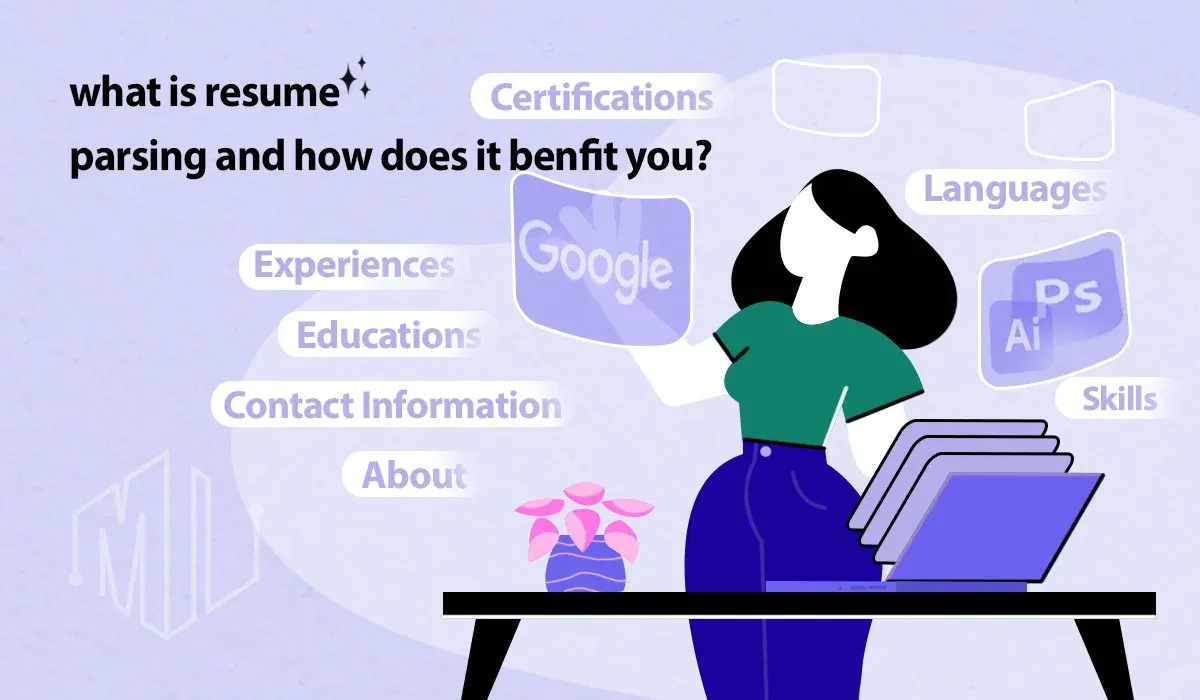What is Resume Parsing and How Does It Benefit You?
Resume parsing is a process in which software analyzes the content of a resume or CV to extract relevant information.

Have you ever wondered how companies can sift through hundreds or even thousands of resumes when hiring for a position?
This seemingly Herculean task is made possible through the use of resume parsers. But what exactly is a resume parser and how does it work?
Recruiters and hiring managers often receive hundreds of resumes for each job opening, making it challenging to identify the most qualified candidates. Resume parsing addresses this challenge by automating the process of extracting and organizing data from resumes, enabling recruiters to quickly identify the best-fit candidates for a position.
✨ Unleash the Power of AI with MagicalAPI!
Whether you’re optimizing YouTube content, extracting LinkedIn data, or evaluating resumes, MagicalAPI is your one-stop solution! Discover the diverse range of AI services tailored to meet your every need. Dive in and elevate your digital experience today!

What Is Resume/CV Parsing?
Resume parsing is the process of extracting relevant information from resumes and converting it into a structured format that can be easily analyzed and searched. It involves the use of resume parsing software, also known as CV parsing software, which uses advanced algorithms to identify and extract key data points from resumes, resume parsing software extracts that information into a format that is readable by machines, such as XML or JSON.
how does a resume parsing software actually work?
Let's break it down step by step.
- Step 1 Document Capture: The first step involves capturing the resume document in a digital format. Once the document is in a digital format, it can be processed by the resume parser.
- Step 2: Text Extraction Once the resume document is captured, the resume parser uses optical character recognition (OCR) technology to extract the text from the document.
- Step Information Extraction: After the text is extracted, the resume parser employs advanced algorithms to identify and extract specific information from the document. It looks for keywords, patterns, and formats to understand the different sections and categories within the resume.
- Step 4 Data Structuring: Once the information is extracted, the resume parser organizes and structures the data into a standardized format. This allows recruiters to easily compare and evaluate different resumes based on specific criteria.
- Step 5 Integration and Analysis: Finally, the parsed data is integrated into the company's applicant tracking system (ATS) or recruitment software. This allows recruiters to efficiently manage and analyze the candidate data, making informed decisions about who to shortlist for interviews and further evaluation.
Features of Resume Parsing Software
Effective resume-parsing software offers several features that enhance the efficiency and accuracy of the parsing process. These features include:
- Data Extraction: The software automatically extracts relevant information from resumes, such as contact details, work experience, education, skills, and certifications.
- Standardization: It standardizes the extracted data, ensuring consistency and uniformity in the format.
- Keyword Identification: The software identifies keywords and phrases relevant to the job requirements, enabling recruiters to quickly search for specific skills or qualifications.
- Integration: Resume parsing software can be integrated with Applicant Tracking Systems (ATS) to streamline the recruitment process and enable seamless data transfer.
- Multilingual Support: Some parsing software supports multiple languages, allowing recruiters to parse resumes in different languages and regions.

Advantages of Resume Parsing
1. Efficiency in Recruitment:
- Time Savings: Automated parsing significantly reduces the time spent manually reviewing resumes, allowing recruiters to focus on more strategic aspects of the hiring process.
- Increased Productivity: Recruiters can quickly filter through a large pool of applicants, shortlisting candidates based on specific criteria.
2. Enhanced Accuracy:
- Minimized Human Error: Parsing tools eliminate the risk of manual errors in data entry, ensuring accurate and consistent information extraction.
- Objective Evaluation: By relying on algorithms, resume parsing promotes an objective evaluation of candidates, minimizing unconscious biases.
3. Improved Candidate Experience:
- Faster Response Times: Job seekers receive quicker responses, enhancing their overall experience with the hiring process.
- Personalized Communication: Recruiters can tailor their communications by leveraging parsed data, making interactions more personalized and engaging.
4. Customization for Specific Roles:
- Tailored Searches: Recruiters can easily search for candidates with specific skills or qualifications, streamlining the hiring process for specialized roles.
- Automated Screening: Parsing tools can be customized to prioritize specific keywords, ensuring that only the most relevant candidates are considered.
Disadvantages of Resume Parsing
While resume parsing offers numerous benefits, it is not without its limitations. The key cons of resume parsing include:
Format Limitations:
Some resume parsing software may struggle to accurately extract data from resumes in non-standard formats or with complex layouts.
Language Limitations:
Resume parsing software may have difficulty parsing resumes in languages other than the primary language(s) it is designed for.
Lack of Contextual Understanding:
Resume parsing software relies on algorithms and predefined rules to extract information, which may not fully capture the nuances and context of certain skills or experiences.
Initial Setup and Configuration:
Implementing resume parsing software may require initial setup and configuration, including mapping data fields and defining parsing rules, which can be time-consuming.
Resume Parsing and Applicant Tracking Systems (ATS)
Resume parsing software can be integrated with Applicant Tracking Systems (ATS) to further streamline the recruitment process. The integration allows for seamless transfer of candidate data between the parsing software and the ATS, eliminating the need for manual data entry.
By integrating resume parsing with an ATS, recruiters can provide a better candidate experience. Automated responses can be sent to candidates, notifying them of the status of their applications and ensuring timely communication throughout the hiring process.
How to Select a Resume Parser
Choosing the right resume parser involves a few key considerations to streamline your hiring processes effectively.
- Evaluate Accuracy: Ensure the resume parser accurately extracts and categorizes resume data.
- Compatibility: Check compatibility with your existing ATS or recruitment software.
- Scalability: Ensure it can scale with your organization's growth.
- User-Friendly: Choose a user-friendly resume parser for a smoother workflow.
- Customer Support: Assess the availability of responsive customer support.
- Budget Alignment: Consider pricing models and licensing to match your budget and needs.
By following these steps, you can choose a resume parser that enhances your hiring efficiency effectively.
Who Can Use Resume Parser Technology?
Resume parser technology streamlines recruitment by automating resume screening for HR professionals, recruiters, and staffing agencies.
Conclusion
Resume parsing technology and resume parsers can benefit both recruiters and job seekers alike. It saves recruiters time by allowing them to search through resumes for qualified candidates quickly; it also makes applying for jobs easier for job seekers since they don’t need to worry about manually reformatting their documents before submitting them.
So if you are looking for ways to make your job search smoother and more efficient – consider using this technology!
FAQ
- What is resume parsing?
Resume parsing is the process of using software to convert unstructured resume data into a structured format, such as XML or JSON. This allows the information to be easily loaded into systems like Applicant Tracking Systems (ATS) or Customer Relationship Management (CRM) platforms. - How do resume parsers work?
Resume parsers work by analyzing resumes to extract specific information. They use technologies like Natural Language Processing (NLP) to identify and process relevant data such as job titles, skills, and work history. The software then organizes this data into a structured format that can be easily sorted and searched by recruiters. - Why use resume parsing?
Resume parsing automates the process of reviewing resumes, significantly reducing the time spent on manual sorting. It increases accuracy by minimizing human error and ensuring no key information is missed. The software helps standardize the evaluation process, ensuring consistency in how candidates are assessed.

Join to our community
By joining our Discord server, get assistance, and troubleshoot any challenges you may encounter while using our services.
Join us on Discord




